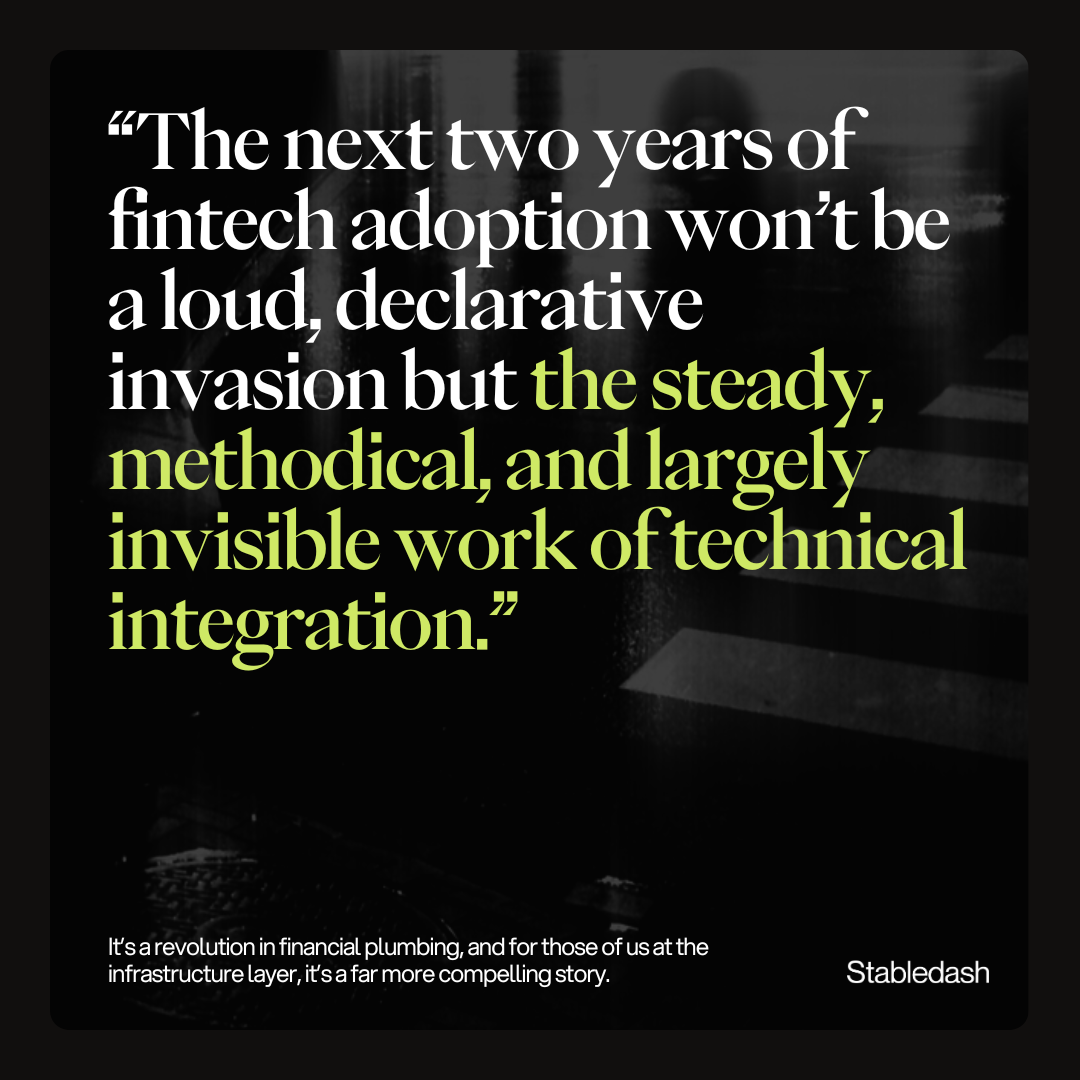Insights
Crypto’s ‘Fintech Invasion’ Is a Myth. Here’s What’s Actually Happening.
Fintech segments are adopting blockchain in radically different ways, and the most important shift is happening behind the scenes.
October 29, 2025

• The "fintech invasion" narrative is a myth. Different fintech segments—remittance, B2B payments, and brokerages—are approaching crypto in radically different ways based on their unique needs.
• Three adoption patterns are emerging: full-stack builders redesigning on blockchain rails, infrastructure-as-a-service adopters using providers like Fireblocks, and feature players adding simple buy/sell buttons via third parties.
• The real battleground is infrastructure, not features. Stablecoin volumes clearing $1.5 trillion monthly reveal the revolution is happening in back-end settlement rails, not consumer-facing crypto apps.
There’s a popular story making the rounds in crypto conference presentations and market commentary.
You’ve probably heard it: “The fintechs are coming.”
It’s a simple, exciting narrative that suggests a tsunami of established financial technology firms is about to flood the crypto ecosystem, bringing with them millions of users and mainstream legitimacy.
It’s a great story. But from where I sit, at the infrastructure level, it’s also a myth.
The idea of a single, sweeping “fintech migration” into crypto is a lazy, hand-wavy analysis.
It misrepresents the nuanced reality on the ground, that we are witnessing a quiet, fragmented, and highly tactical adoption process.

Deconstructing the “Fintech” Monolith
The overarching mistake in this popular narrative is bundling all “fintechs” into a single category.
In reality, “fintech” is a sprawling ecosystem of wildly different business models. A cross-border remittance company, a B2B payments platform, and a retail brokerage app have about as much in common as a cargo ship, a race car, and a bicycle.
They may all be forms of transportation, but they are designed for different purposes, operate under different rules, and have fundamentally different engineering needs.
Why would we expect their crypto strategies to be the same?
- Remittance & Cross-Border Payments (e.g., Wise, Remitly): These firms are obsessed with lowering costs and settlement times for international transfers. For them, stablecoins aren’t speculative assets to offer users; they're a backend payment rail poised to replace slow, expensive correspondent banking networks. Their primary challenge is navigating a complex web of global regulations and ensuring liquidity at the edges.
- B2B Payment Platforms (e.g., Bill.com, Melio): These companies solve accounts payable and receivable for businesses. They want the finality and efficiency of blockchain settlement, but with the familiarity and stability of the dollar. For them, crypto is an infrastructure upgrade for B2B trade, focused on programmable payments and real-time settlement.
- Brokerage & Wealth Tech (e.g., Robinhood, Public): This segment is driven by user demand for asset exposure. For them, adding crypto is often a feature-level decision aimed at retaining users and capturing trading revenue. Their core business isn’t being re-architected; they are simply adding a new asset class, often through third-party integrations.
These distinct segments represent only a fraction of the broader fintech industry, and grouping them together obscures the tactical reality.
Now that we've deconstructed it, the next, more useful, question to focus on is: how are different types of fintechs using crypto to solve targeted problems?
A Tale of Three Tactical Approaches
From our view at the infrastructure layer, we see three distinct adoption patterns emerging.
1. The “full-stack” approach (the true believers)
This is the most ambitious and transformative approach.
A small but growing number of companies like Circle are building end-to-end financial infrastructure directly on blockchain rails. Rather than adapting existing systems, they design every layer (issuance, settlement, compliance, and liquidity) to run natively on crypto networks.
This involves building core components of the stack in-house: developing their own key infrastructure, orchestrating stablecoin issuance and redemption, and settling transactions directly onchain.
Some, like Circle, run their own stablecoin or blockchain-based settlement layers. This path offers unmatched control but also the heaviest technical and regulatory lift.
2. The “Infrastructure as-a-service” approach
This is where the majority of established, large-scale fintechs are quietly placing their bets.
These firms want the benefits of crypto—namely, speed and cost efficiency—without the immense complexity and risk of managing their own core blockchain infrastructure.
They are turning to a new generation of infrastructure providers (Fireblocks, Zero Hash, Coinbase Cloud, Circle, and others) that securely manage critical components like key custody and settlement. This effectively abstracts away the complex layers of crypto while providing the security, flexibility, and scalability to innovate.
This allows fintechs like Stripe to move millions of dollars in USDC with a single API call across a public blockchain, settling in seconds, without ever needing to build a node, manage a private key, or touch the underlying crypto asset.
They get the rails without having to build the railroad.
This is the most powerful and, in my view, the most important trend, as it provides a scalable, compliant, and low-risk pathway for mainstream adoption.
3. The “feature” approach (the cautious experimenters)
This is the most visible and, frankly, the most lightweight form of adoption.
This is what most people think of when talking about “fintechs coming to crypto.” It typically involves a brokerage or neobank adding a “buy/sell/hold” capability for a handful of cryptocurrencies.
In almost all cases, this functionality is entirely outsourced to a third-party exchange or crypto-as-a-service provider.
For example, N26 integrated Bitpanda for crypto trading. Monese integrated Coinbase for crypto buying and selling. And even large banks like PNC are using Coinbase’s crypto-as-a-service to bring crypto into their interface.
The fintech is effectively just a marketing funnel. While it normalizes crypto for a wider audience, it has virtually zero impact on the fintech’s core infrastructure. It’s a user acquisition play, not a strategic overhaul.
The View from Onchain: Data Trumps Narrative
The onchain data for 2025 backs up this story of fragmentation, not invasion.
While market commentary focuses on the “Feature” approach, the real growth is in payments and settlement—the domain of the “full-stack” and “Infrastructure-as-a-service” players.
A quick look at stablecoin activity is illuminating.
We’ve seen the total stablecoin market cap hovering around $308 billion as of late October 2025, yet onchain transfer volumes are clearing $1.5 trillion per month.
Loading...
This discrepancy shows that stablecoins are not just sitting idle as a store of value but are being used at an incredible velocity for settlement.
A large portion of this volume is also happening on high-throughput, low-cost chains like Solana and TRON, which are optimized for payment use cases rather than just DeFi trading.
This is the quiet, industrial-scale adoption that doesn’t make headlines but is profoundly changing the plumbing of the financial system. These B2B transaction flows and cross-border settlements are enabled by the infrastructure providers powering innovation behind the scenes.
The Real Battleground Is in the Stack
This nuanced reality means the true competitive landscape is in the infrastructure stack itself.
The core battle is between providers of payments infrastructure, key management, and asset issuance, each working to deliver the most secure, scalable, and developer-friendly tools for “Infrastructure-as-a-service” fintechs building on crypto rails.
The winners will be the providers building the foundational tools and systems that enable the pragmatic majority of fintechs to integrate crypto at the core, not those catering to the speculative hype cycles of the “feature” players.
A New Mental Model for Adoption
It’s time to discard the lazy narrative of a “fintech invasion.” It’s a compelling story, but it doesn’t reflect the tactical reality we see being built every day. The truth requires a new mental model.
Instead of a single wave, picture a series of targeted deployments by distinct fintech segments using one of three strategic playbooks: full-stack, Infrastructure-as-a-service, or feature.
Understanding this fragmented approach is key to spotting real trends versus noise. The most profound shift isn’t coming from a neobank slapping a “buy Bitcoin” button on its app.
It’s coming from the quiet, back-end integration of stablecoin settlement rails by a B2B payments platform, enabled by a sophisticated infrastructure provider.

Don't Miss the Next Big Shift
The Stabledash newsletter keeps you off the timeline and dialed into modern money.
Join leaders at Circle, Ripple, and Visa who trust us for their stablecoin insights.



